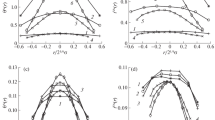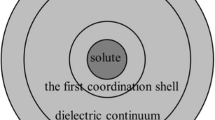Abstract
The lattice gas model is generalized to describe the equilibrium distributions of polar solution components with allowance for Lennard-Jones and dipole-dipole potential interactions with constant and induced moments. It is shown that including induced dipoles potential results in an effective many-particle interaction potential, depending on the spatial distribution of solution components. The distributions of all solution components are calculated in a quasi-chemical approximation allowing for the spatial correlation of interacting particles. A procedure for reducing the dimensionality of a set of algebraic equations is considered, and expressions for vapor-liquid equilibrium isotherms are obtained. Expressions for the rates of elementary mono- and bimolecular chemical reactions are derived using the transition state theory in systems with induced dipoles for rapidly overcoming the activation barrier in the permanent state of solvent molecules’ atomic subsystems. Ways of considering the internal motions (vibrations, rotation, and displacements) of molecules in a polar liquid are discussed.
Similar content being viewed by others
References
J. O. Hirschfelder, Ch. F. Curtiss, and R. B. Bird, Molecular Theory of Gases and Liquids (Wiley, New York, 1954).
Intermolecular Forces, Ed. by J. O. Hirschfelder, Advances in Chemical Physics (Interscience Publ., New York, 1967), Vol. 12.
I. G. Kaplan, Introduction to the Theory of Molecular Interactions (Nauka, Moscow, 1982).
C. G. Gray and K. E. Gubbins, Theory of Molecular Fluids (Clarendon Press, Oxford, 1984), Vol. 1.
Intermolecular Interactions: From Diatomics to Biopolymers, Ed. by B. Pullman (Wiley, 1978; Mir, Moscow, 1981).
Molecular Interactions, Ed. by H. Ratajczak and W. J. Orwill-Thomas (Wiley, New York, 1989; Mir, Moscow, 1984).
N. G. Bakhshiev, Spectroscopy of Intermolecular Interactions (Nauka, Leningrad, 1972) [in Russian].
G. C. Pimentel and A. L. McClellan, The Hydrogen Bond (Mir, Moscow, 1964; Freeman, San Francisco, 1960).
N. A. Smirnova, Molecular Models of Solutions (Khimiya, Leningrad, 1987) [in Russian].
N. F. Stepanov and V. I. Pupyshev, Quantum Mechanics of Molecules and Quantum Chemistry (Mosk. Gos. Univ., Moscow, 1991) [in Russian].
G. M. Bell, J. Phys. C 5, 889 (1972).
G. M. Bell and D. W. Salt, J. Chem. Soc.: Faraday Trans. 2 72, 76 (1976).
Yu. V. Shulepov and E. V. Aksenenko, Lattice Gas (Naukova dumka, Kiev, 1981) [in Russian].
S. V. Titov and Yu. K. Tovbin, Russ. Chem. Bull. 60, 11 (2011).
S. V. Titov and Yu. K. Tovbin, Russ. J. Phys. Chem. A 85, 185 (2011).
S. G. Entelis and R. P. Tiger, Reaction Kinetics in the Liquid Phase (Khimiya, Moscow, 1973) [in Russian].
E. A. Moelwin-Hughes, The Kinetics of Reactions in Solution (Oxford Univ., London, 1950; Khimiya, Moscow, 1975).
R. R. Dogonadze and A. M. Kuznetsov, in Results of Science and Engineerign. Kinetics and Catalysis (VINITI, Moscow, 1978), Vol. 5 [in Russian]
E. D. German and A. M. Kuznetsov, in Results of Science and Engineerign. Kinetics and Catalysis (VINITI, Moscow, 1982), Vol. 10, p. 115 [in Russian].
R. R. Dogonadze and T. A. Marsagishvili, Khim. Fiz. 7, 33 (1988).
Yu. K. Tovbin, Russ. J. Phys. Chem. A 70, 1655 (1996).
S. V. Titov and Yu. K. Tovbin, Russ. J. Phys. Chem. A 87, 185 (2013).
Yu. K. Tovbin, Molecular Theory of Adsorption in Porous Bodies (Fizmatlit, Moscow, 2012) [in Russian].
Yu. K. Tovbin, Russ. J. Phys. Chem. A 80, 1554 (2006).
B. M. Axilrod and E. Teller, J. Chem. Phys. 11, 299 (1943).
J. Dias da Silva, J. Brandao, and A. J. C. Varandas, J. Chem. Soc., Faraday Trans. 85, 1851 (1989).
J. A. Barker, in Rare Gas Solids, Ed. by M. L. Klein and J. A. Venables (Academic, London, 1976), Vol. 1, p. 212.
Yu. K. Tovbin, Zh. Fiz. Khim. 61, 2711 (1987).
Yu. K. Tovbin, Russ. J. Phys. Chem. A 86, 1212 (2012).
A. Migus, Y. Gauduel, J. L. Martin, and A. Antonetti, Phys. Rev. Lett. 58, 1559 (1987).
I. A. Misurkin and S. V. Titov, Russ. J. Phys. Chem. A 74, 1314 (2000).
I. A. Misurkin and S. V. Titov, Russ. J. Phys. Chem. A 73, 276 (1999).
I. A. Misurkin and S. V. Titov, Russ. J. Phys. Chem. A 74, 827 (2000).
I. A. Misurkin and S. V. Titov, Russ. J. Phys. Chem. A 78, 637 (2004).
I. A. Misurkin and S. V. Titov, Russ. J. Phys. Chem. A 79, 1799 (2005).
I. A. Misurkin and S. V. Titov, Russ. J. Phys. Chem. A 79, 84 (2005).
I. A. Misurkin and S. V. Titov, Russ. J. Phys. Chem. A 81, 204 (2007).
I. A. Misurkin and S. V. Titov, Russ. J. Phys. Chem. A 81, 69 (2007).
I. A. Misurkin and S. V. Titov, Russ. J. Phys. Chem. A 82, 1672 (2008).
Yu. K. Tovbin and E. V. Votyakov, Russ. J. Phys. Chem. A 71, 214 (1997).
Yu. K. Tovbin and S. V. Titov, Russ. J. Phys. Chem. B 5, 1135 (2011).
L. D. Landau and E. M. Lifshitz, Course of Theoretical Physics, Vol. 2: The Classical Theory of Fields (Nauka, Moscow, 1988; Pergamon, Oxford, 1975).
P. Stampfli, J. Chem. Phys. 101, 6024 (1994).
Yu. K. Tovbin, Zh. Fiz. Khim. 69, 118 (1995).
Yu. K. Tovbin, Zh. Fiz. Khim. 69, 214 (1995).
N. A. Smirnova, in Chemistry and Thermodynamics of Solutions (Len. Gos. Univ., Leningrad, 1968), No. 2, p. 8 [in Russian]; in Chemistry and Thermodynamics of Solutions (Len. Gos. Univ., Leningrad, 1982), No. 5, p. 87 [in Russian].
J. A. Barker and W. Fock, Disc. Faraday Soc., No. 15, 188 (1953).
G. A. Anderson and J. C. Wheeler, J. Chem. Phys. 69, 2082 (1978).
J. C. Walker and C. A. Vause, Phys. Lett. A 79, 421 (1980).
R. E. Goldstein and J. C. Walker, J. Chem. Phys. 78, 1492 (1983).
J. C. Walker and C. A. Vause, J. Chem. Phys. 78, 2660 (1983).
I. N. Godnev, Calculation of Thermodynamical Functions using Molecular Data (GITTL, Moscow, 1956) [in Russian].
Yu. K. Tovbin, Theory of Physicochemical Processes at the Gas-Solid Interface (Nauka, Moscow, 1990; Mir, CRC, Moscow, Boca Raton, FL, 1991).
I. Z. Fisher, Statistical Theory of Liquids (Chicago Univ., Chicago, 1964; Fizmatgiz, Moscow, 1961).
C. Croxton, Liquid State Physics (Cambridge Univ., London, 1974; Mir, Moscow, 1979).
G. A. Martunov, Fundamental Theory of Liquids: Method of Distribution Functions (Adam Hilger, Bristol, 1992).
Yu. K. Tovbin, Zh. Fiz. Khim. 66, 1395 (1992).
Yu. K. Tovbin, Progress Surf. Sci. 34, 1 (1990).
S. Glasstone, K. J. Laidler, and H. Eyring, The Theory of Rate Processes: The Kinetics of Chemical Reactions, Viscosity, Diffusion and Electrochemical Phenomena (Van Nostrand, New York, 1941).
Yu. K. Tovbin, M. M. Senyavin, and L. K. Zhidkova, Russ. J. Phys. Chem. A 73, 245 (1999).
Yu. K. Tovbin, Russ. J. Phys. Chem. A 87, 1083 (2013).
Yu. K. Tovbin, Khim. Fiz. 21(1), 83 (2002).
M. I. Ryazanov, Electrodynamics of Condenced Matter (Nauka, Moscow, 1984) [in Russian].
Author information
Authors and Affiliations
Corresponding author
Additional information
Original Russian Text © Yu.K. Tovbin, 2014, published in Zhurnal Fizicheskoi Khimii, 2014, Vol. 88, No. 11, pp. 1752–1765.
Rights and permissions
About this article
Cite this article
Tovbin, Y.K. Considering induced dipoles in a discrete model of a polar liquid. Russ. J. Phys. Chem. 88, 1932–1944 (2014). https://doi.org/10.1134/S0036024414110181
Received:
Published:
Issue Date:
DOI: https://doi.org/10.1134/S0036024414110181




